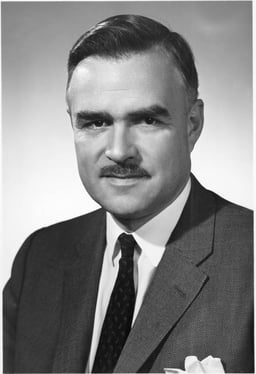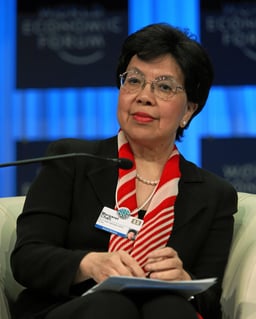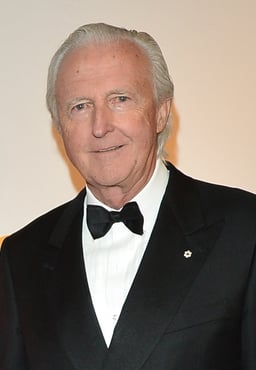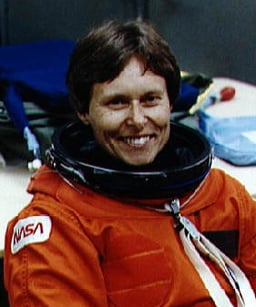University of Western Ontario
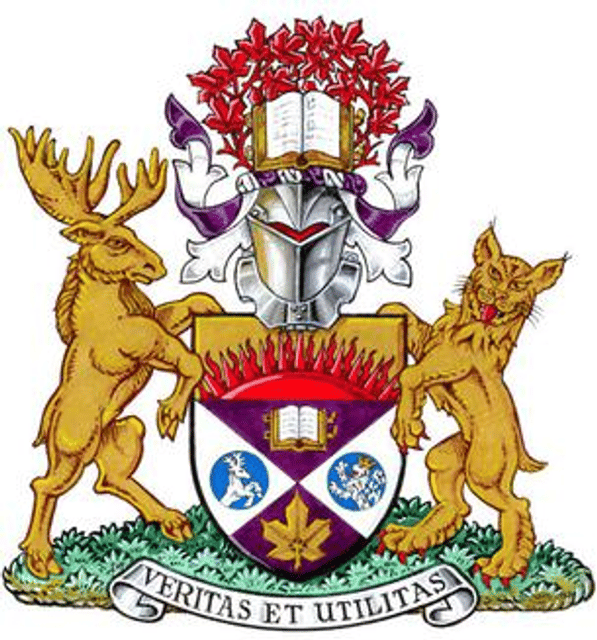
University of Western Ontario

| Latin: Universitas Occidentis Ontariensis | |
Former names | Western University of London, Ontario (1878–1923) |
|---|---|
| Motto | Latin: Veritas et Utilitas |
Motto in English | Truth and usefulness |
| Type | Public |
| Established | March 7, 1878 |
Academic affiliations | ACU AUCC CARL CBIE COU CUP CUSID Fields Institute U15 |
| Endowment | C$746.5 million[1] |
| Budget | C$754.2 million[2] |
| Chancellor | Linda Hasenfratz |
| President | Alan Shepard |
Academic staff | 1,391[3] |
| Undergraduates | 31,638[4] |
| Postgraduates | 5,297[5] |
| Location | London ,,Canada |
| Campus | Urban, 455 hectares (1,120 acres)[6] |
| Colours | Purple and white[7] |
| Athletics | U Sports OUA |
| Nickname | Mustangs |
| Mascot | JW the Mustang[8] |
| Fight song | Western Mustangs Fight Song |
| Website | uwo.ca [171] |
 | |
| University rankings | |
| Global rankings | |
| ARWU World[85] | 201–300 |
| QS World[86] | 211 |
| Times World[87] | 190 |
| U.S News & World Report Global[88] | 276 |
| Canadian rankings | |
| ARWU National[85] | 10–12 |
| QS National[86] | 8 |
| Times National[87] | 8 |
| U.S News & World Report National[88] | 11 |
| Maclean's Medical/Doctoral[89] | 7 |
| Maclean's Reputation[90] | 6 |
University of Western Ontario (UWO), corporately branded as Western University as of 2012 and commonly shortened to Western, is a public research university in London, Ontario, Canada. The main campus is on 455 hectares (1,120 acres) of land, surrounded by residential neighbourhoods and the Thames River bisecting the campus's eastern portion. The university operates twelve academic faculties and schools. It is a member of the U15, a group of research-intensive universities in Canada.
The university was founded on 7 March 1878 by Bishop Isaac Hellmuth of the Anglican Diocese of Huron as the Western University of London, Ontario. It incorporated Huron University College, which had been founded in 1863. The first four faculties were Arts, Divinity, Law and Medicine. The Western University of London became non-denominational in 1908. Beginning in 1919, the university has affiliated with several denominational colleges. The university grew substantially in the post-World War II era, as a number of faculties and schools were added to university.
Western is a co-educational university, with more than 24,000 students, and with over 306,000 living alumni worldwide. Notable alumni include government officials, academics, business leaders, Nobel Laureates, Rhodes Scholars, and distinguished fellows. Western's varsity teams, known as the Western Mustangs, compete in the Ontario University Athletics conference of U Sports.
| Latin: Universitas Occidentis Ontariensis | |
Former names | Western University of London, Ontario (1878–1923) |
|---|---|
| Motto | Latin: Veritas et Utilitas |
Motto in English | Truth and usefulness |
| Type | Public |
| Established | March 7, 1878 |
Academic affiliations | ACU AUCC CARL CBIE COU CUP CUSID Fields Institute U15 |
| Endowment | C$746.5 million[1] |
| Budget | C$754.2 million[2] |
| Chancellor | Linda Hasenfratz |
| President | Alan Shepard |
Academic staff | 1,391[3] |
| Undergraduates | 31,638[4] |
| Postgraduates | 5,297[5] |
| Location | London ,,Canada |
| Campus | Urban, 455 hectares (1,120 acres)[6] |
| Colours | Purple and white[7] |
| Athletics | U Sports OUA |
| Nickname | Mustangs |
| Mascot | JW the Mustang[8] |
| Fight song | Western Mustangs Fight Song |
| Website | uwo.ca [171] |
 | |
| University rankings | |
| Global rankings | |
| ARWU World[85] | 201–300 |
| QS World[86] | 211 |
| Times World[87] | 190 |
| U.S News & World Report Global[88] | 276 |
| Canadian rankings | |
| ARWU National[85] | 10–12 |
| QS National[86] | 8 |
| Times National[87] | 8 |
| U.S News & World Report National[88] | 11 |
| Maclean's Medical/Doctoral[89] | 7 |
| Maclean's Reputation[90] | 6 |
History
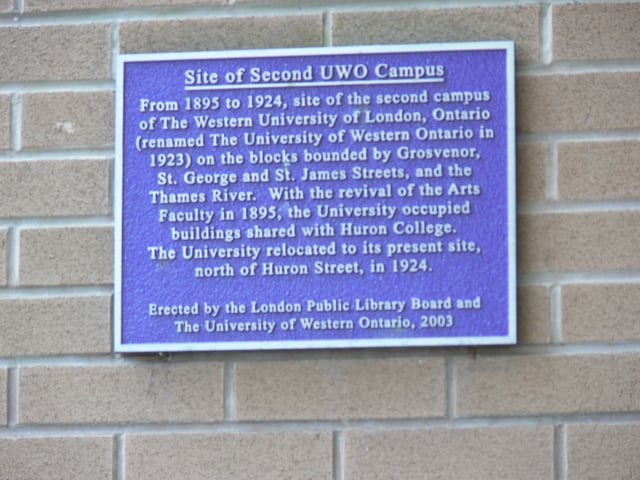
A plaque at St. George and St. James Street at the former location of Western's campus, from 1895 to 1924.
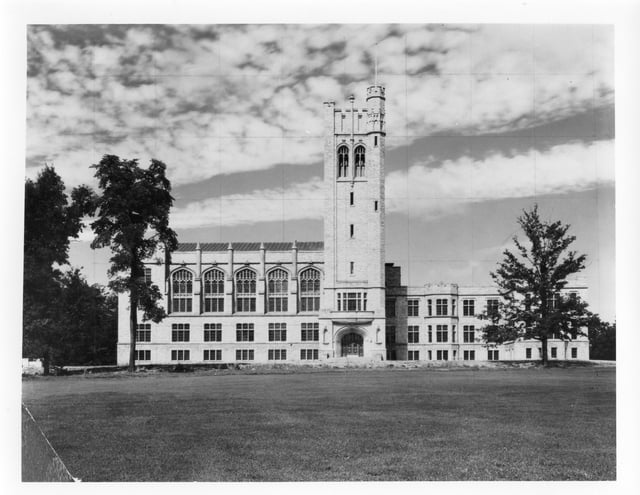
University College in June 1924. Opened in 1924, it was one of the first buildings to be completed at the present campus.

University College tower was used as the logo of Western prior to its re-brand, from 1998 to 2012.
The university was founded on 7 March 1878 by Bishop Isaac Hellmuth of the Anglican Diocese of Huron as The Western University of London Ontario, and its first chancellor was Chief Justice Richard Martin Meredith.[9] It incorporated Huron College, which had been founded in 1863.[10] The first four faculties were Arts, Divinity, Law and Medicine (London Medical College).[11] There were originally only 15 students when classes began in 1881.[12][9]
Although the university was incorporated in 1878, it was not until 20 June 1881 that it received the right to confer degrees in Arts, Divinity and Medicine. In 1882, the name of the university was revised to The Western University and College of London, Ontario.[13] The first convocation of graduates was held on 27 April 1883.[11] Initially affiliated with the Church of England,[13] Western became non-denominational in 1908.
In 1916, the university's current site was purchased from the Kingsmill family. There are two World War I memorial plaques in University College. The first lists the 19 students and graduates of the University of Western Ontario who lost their lives; the second honours the men from Middlesex County who died.[14][15] A third plaque lists those who served with the No. 10 Canadian General hospital during WWII, the unit raised and equipped by UWO.[15]
In 1923, the university was renamed The University of Western Ontario.[9] The first two buildings constructed by architect John Moore and Co. at the new site were the Arts Building (now University College) and the Natural Science Building (now the Physics and Astronomy Building).[16] Classes on the university's present site began in 1924.[17] The University College tower, one of the university's most distinctive features, was named the Middlesex Memorial Tower in honour of the men from Middlesex County who fought in World War I.
In 1919, the Ursuline Sisters had established Brescia College as a Roman Catholic affiliate, and in the same year Assumption College in Windsor affiliated with the university; it evolved into the University of Windsor in 1953.[10][18] Before the end of the affiliation, Assumption College was one of the largest colleges associated with the university. Similarly, Waterloo College of Arts became affiliated with Western in 1925;[10][19] which eventually became today, the Wilfrid Laurier University (1960), emphasizing liberal arts, and the University of Waterloo, emphasizing engineering and science. St. Peter's College seminary of London, Ontario was later became affiliated with Western in 1939, and it became King's College, an arts college.[10] Today, King's, Huron and Brescia colleges are all still affiliates of Western.
Two World War II memorial honour rolls are hung on the Physics and Astronomy Building: the first lists the UWO students and graduates who served in the Second World War, and the second lists those who served with the No. 10 Canadian General hospital during WWII, the unit raised and equipped by UWO.[15]
Although enrollment was relatively small for many years, the university began to grow after World War II. It added a number of faculties in the post-war period, such as the Faculty of Graduate Studies (1947), the School of Business Administration (now the Ivey Business School) (1949),[20] the Faculty of Engineering Science (now the Faculty of Engineering) (1957), the Faculty of Law (1959), and Althouse College for education students (now the Faculty of Education) (1963) and the Faculty of Music (1968).[21]
In 2012, the university rebranded itself as "Western University" to give the school less of a regional or even national identity. "We want to be international," president Dr. Amit Chakma told The Globe and Mail. The university's legal name, however, remains "The University of Western Ontario" and is used on transcripts and diplomas.[22]
Campus

Middlesex College is a Collegiate Gothic building completed in 1960. From 1922 to the late 1960s, most of the buildings completed at Western utilized Collegiate Gothic designs.
The University of Western Ontario is in the city of London, Ontario, in the southwestern end of the Quebec City–Windsor Corridor. Most of the campus is surrounded by residential neighbourhoods, with the Thames River bisecting the campus' eastern portion. Western Road is the university's major transportation artery, going north to south. The central campus, which includes most of the University's student residences and teaching facilities is approximately 170.8 hectares (422 acres).[6]
Student residences make up the largest part of Western's building area, with approximately 31 percent of all building space allocated for residential use. Teaching and research facilities take up the second largest portion of building space, with approximately 28 percent of all building space allocated for that use. Most of these facilities are used for research, with 48 percent of all teaching and research facilities allocated for that purpose. Approximately 27 percent of all teaching and research facilities is made up of classrooms, with the remaining 24 percent made up of instructional laboratories.[23]
The development of Western's present campus began in 1920s. Many of the University's earliest buildings used Collegiate Gothic designs, a characteristic confirmed in Western's master building plan in 1934.[24] As the campus expanded in the late 1960s, the university abandoned earlier commitments to Collegiate Gothic designs in favour of brutalist and modernist architectural designs.[24] In 2000, planning for Western's central campus was re-conceptualized, with the core devoted for only academic buildings. The plan saw University College Hill as the focal point, linking the lower portion of the campus with the South Valley[24] The 2006 campus master plan called for the protection and renewed emphasis on Western's Collegiate Gothic buildings.[24] The University's boiler room/power plant is the oldest building on the University's central campus, opening in 1922.[25] The oldest academic buildings within the central campus is University College and the Physics and Astronomy Building. Groundbreaking for both buildings began in 1922, and were both completed in 1924.[25] The FIMS and Nursing building is the newest academic building on campus, opening in 2017.[25] The Western Interdisciplinary Research Building, or WIRB, is the newest building on campus and houses state-of-the art research facilities for the study of cognitive neuroscience as well as the Brain and Mind Institute, BrainsCAN, and the Rotman Institute for Philosophy.[26]
Library and museums
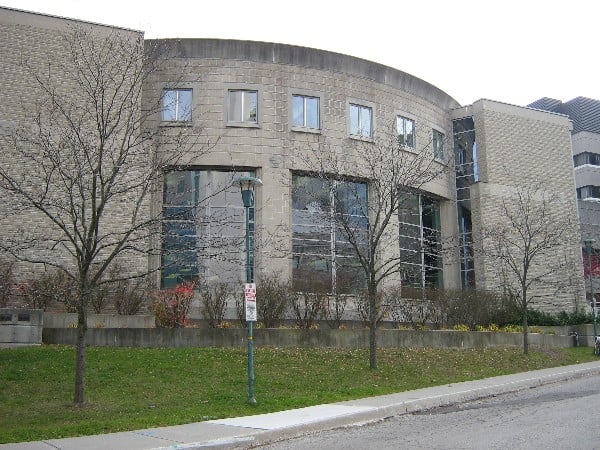
The Allyn and Betty Taylor Library is one of the six branches of the Western Libraries.
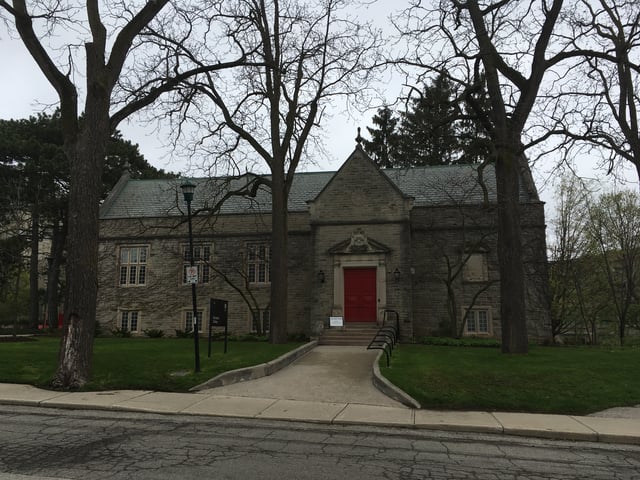
McIntosh Gallery is one of two art galleries located on its campus.
The University's library system, Western Libraries, operates six libraries that house more than 2.45 million books as of September 2015, as well as electronic resources including e-books, serial titles, and databases.[27] Libraries a part of the system include the Allyn and Betty Taylor Library, C. B. Johnston Library, the D. B. Weldon Library, the Education Library, the John & Dotsa Bitove Family Law Library, and the Music Library.[28] Allyn and Better Taylor Library primarily services the faculties of Engineering, Health Sciences, Science, and the Schulich School of Medicine & Dentistry, while the C. B. Johnston Library primarily serves the Ivey Business School. The D. B. Weldon Library primarily services the faculties of Arts & Humanities, Information & Media Studies, and Social Sciences. The D. B. Weldon Library also houses the University's Archives and Research Collections Centre.[29] Western Libraries also maintains the Shared Library Catalogue, which provides common access to the collections of Western Libraries, as well as the collections from the libraries of university colleges affiliated with the Western, including Brescia University College, Huron University College, King's University College, and St. Peter's Seminary. Access to the Shared University Catalogue is provided to students and faculty of Western, and the affiliated university colleges.[30]
Western also operates two art galleries, the Artlab Gallery, and the McIntosh Gallery. Located in the John Labatt Visual Arts Centre, the Artlab Gallery showcases approximately 14 projects per year, exploring conceptual and experimental production through a wide range of media. The Artlab Gallery also aims to assist in the research and practices of students and faculty members.[31] The McIntosh Gallery is a university-based, public art gallery, opened since 1942. The gallery is a presentation and dissemination centre for the university, as well as the London community, showcasing advanced practices and research in art history and contemporary visual art.[32] The gallery is the oldest university art gallery in the province of Ontario, initially opened as an exhibition of paintings by war artists from the National Gallery of Canada.[33] 683 works of the Gallery's collection were put on display throughout the University's main campus through the Gallery's ArtShare program in 2014.[34]
Western also maintains academic and administrative links with the Museum of Ontario Archaeology. The Museum originally grew out of a collection of artifacts housed in various buildings throughout London, including Western's University College, and Middlesex College. Formally opened on 28 February 1978, its creation was facilitated by the University President and Western's Faculty of Social Science. Although the museum was incorporated as an independent charitable organization, without the ability to share capital, its directors continued to be appointed by the University's Board of Governors.[35]
Housing and student facilities
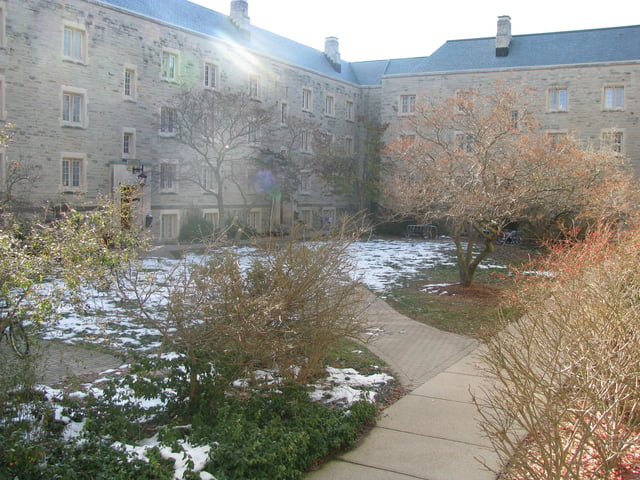
Sydenham Quad within Medway-Sydenham Hall, one of nine student residences at the university's campus
The main campus of The University of Western Ontario offers student housing, with nine student residences housing either first-year students or upper-year students. In September 2015, 23.49 percent of the undergraduate population lived on campus, including 78.69 percent of all first-year students.[27] Each residence operates their own Residences' Council, governed by their own constitutions.[36] Student residence building are split between traditional-styled residences, suite-styled residences, and hybrid-style residences that incorporate elements of traditional and suite-styled residences.
Traditional-styled residences include Delaware Hall, Medway-Sydenham Hall, and Saugeen-Maitland Hall. Suite-styled residences include Alumni House, Elgin Hall, Essex Hall, and London Hall. Hybrid-styled residences include Perth Hall and Ontario Hall.[37] Alumni House and London Hall is reserved strictly for upper-year student.[38] The largest residential building at the university is Saugeen–Maitland Hall, which houses 1,252 first-year students. The smallest residential building is Alumni House, which houses 224 upper-year students.[39][40] The university also operates three apartments on campus strictly for upper-year and graduate students. The University's apartments consist of Bayfield Hall, made up of 299 1-bedroom units, Beaver & Ausable Halls, made up of 99 2-bedroom units, and Lambton Hall, made up of 150 2-bedroom units.[41]
The University Community Centre acts as Western's student activity centre, and is the University's centre of student governance and student directed social, cultural, entertainment and recreational activities. The University Community Centre contains the offices of a number of student organizations, including the undergraduate student union, the University Students' Council, as well as the graduate student union, the Society of Graduate Students. In addition, the University Community Centre also provides a number of retail and food services, as well as a variety of club space and study rooms.[42]
Off-campus facilities
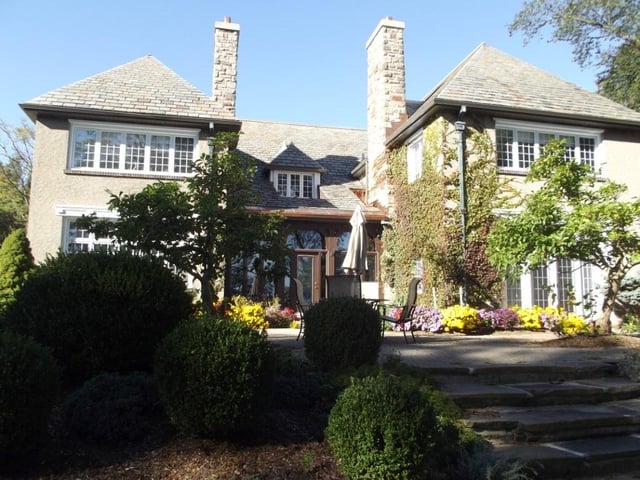
Gibbons Lodge serves as the official residence for the University President. It is one of several university-owned properties outside its main campus.
In addition to The University of Western Ontario's central campus, the university owns several other properties throughout Southwestern Ontario. Excluding Western's central campus, as well as the campuses of Western's affiliated university colleges, Western owns approximately 309.6 hectares (765 acres) of land. Included among these properties is a number of research facilities. Managed under Western Research Parks, the facilities are clustered into three research parks. The three parks serve as a research link between academics and corporations.[43]
The oldest research park operated by Western is Discovery Park, adjacent to the University's main campus. The 16.2 hectares (40 acres) research park was established in 1989, with tenants ranging from national government laboratories, to large-multi-industrial research centres. Discovery Park also includes a 48-room hotel and conference centre, Windermere Manor.[44] The Advanced Manufacturing Park is another research park established through a partnership between Western, Fanshawe College and the City of London. Advanced Manufacturing Park is a 52.6 hectares (130 acres) research park, built in an area zoned for full-scale manufacturing and large-scale research.[45] The WindEEE Dome is among the facilities built in the Advanced Manufacturing Park. The WindEEE Dome is the world's first hexagonal wind tunnel, allowing for scientists to address certain challenges related to wind. The structure is able to accommodate replicas of buildings, and bridges to test for structural integrity in a variety of wind conditions. The facility is able to physically simulate high intensity wind systems, including tornados, and downbursts hard to replicate in other wind tunnels.[46] In 2003, Western opened another research park known as the Sarnia-Lambton Research park, in a joint initiative with Lambton County, and Sarnia. The 32.4 hectares (80 acres) research park is adjacent to Lambton College and is home to Canada's largest clean technology business incubator.[47]
The university also manages several residences outside the central campus. The official residence of the University President, Gibbons Lodge, is off-campus. Completed in 1932, the Tudor Revival-styled house is north of Western's central campus. It was acquired by the university in 1960.[48] In addition to Gibbons Lodge, the university also maintains Platt's Lane Estates, a complex of townhouses and apartments south of the University's campus. The complex was designed to accommodate upper-year, graduate, and students with families.[49]
Sustainability
Campus sustainability at Western is managed by the President's Advisory Committee on Environment & Sustainability. The committee's mandate includes incorporating sustainability into the academic programming, engaging in research across the disciplines into issues of environmental sustainability, using ecological landscaping methods and preserving green space and building and renovating facilities in accordance with energy efficiency and sustainability principles[50] Along with the other members of the Council of Ontario Universities, Western had signed a pledge in 2009 known as Ontario Universities Committed to a Greener World, with the objective of transforming its campus into a model of environmental responsibility.[51] Western is also a signatory of the Talloires Declaration, a sustainability declaration created for presidents of higher education.[52] The university campus received a B- grade from the Sustainable Endowments Institute on its College Sustainability Report Card for 2011.[53]
Administration
The university's governance is conducted through the Board of Governors and the Senate. The Senate was the university's first governing body, created in the university's founding document, An Act to Incorporate the Western University of London, Ontario, 1878.[54] The Board of Governors was later established in An Act to amend the Act to incorporate the Western University of London, Ontario, 1892.[55] The Board is responsible for the university's management, including financial matters.[56] Ex officio governors of the Board include the university's chancellor, president, the mayor of London, the warden of Middlesex County and the secretary of the Board of Governors. The Board also consists of 26 other governors either appointed or elected by the members of the university's community and the surrounding community, including elected representatives from the student body.[57]
The Senate is responsible for the university's academic policies.[58] The Senate consists of 20 ex officio positions in the Senate granted to the chancellor, the president, the university's vice-presidents, the senior dean of each faculty, the university librarian and the secretary of the senate. The secretary of the senate is a non-voting ex officio member. The Senate also consists of 46 elected members from the university's faculty, 18 members from the student population, and 9 members from the Western's affiliated colleges, including their principals. The Senate also consists of 9 other members from around the university community. In all, there are 103 members of the Senate, 102 of which may vote and 10–13 official observers of the Senate.[59]
The president and vice-chancellor acts as the university's chief executive officer, accountable to the Board of Governors and the Senate, by supervising and directing the university's academic and administrative work and its teaching and non-teaching staff.[60] Alan Shepard is the tenth president of the university, serving since 1 July 2009.[61] The chancellor of the university acts as the honorary and symbolic head of the university. The position of chancellor is a four-year, non-renewable term.[62] The university's previous chancellor was Jack Cowin, who held the position until June 2019.[63] The university's current chancellor is Linda Hasenfratz, who has held the position since 1 July 2019.[64]
Affiliated institutions

St. Peter's Seminary is an affiliated institution of Western. St. Peter's is the seminary for the local diocese.
The University of Western Ontario is affiliated to three university colleges. Brescia University College is an all-women's Catholic-based university college, the only remaining women's college in Canada.[65] Founded by the Ursulines in 1919, an affiliation agreement with Western was arranged shortly after its founding, with Brescia campus moving adjacent to Western's central campus in 1925.[66] Huron University College was founded in 1863, originally established as Huron College, and renamed Huron University College in 2000.[67] Huron's affiliation with Western was authorized in Western's first provincial charter, in 1878. Both Huron and Western share the same progenitor in Bishop Issac Hellmuth. Huron moved to its present location, adjacent to Western's central campus, in 1951.[67] King's University College was founded in 1954, as a Catholic-based liberal arts college.[68] Founded as Christ the King's College, it changed its name to King's College in 1966, and King's University College in 2004.[69] Regardless of the university college's religious affiliation, enrolment in the those institutions is not restricted based on the student's religious beliefs.[68][65]
In addition to the three university colleges, Western also maintains an affiliation with St. Peter's Seminary through its affiliation with King's University College.[70] Founded in 1912, St. Peters was opened as the seminary for the Roman Catholic Diocese of London.[71] The campuses of King's University College and St. Peter's Seminary are east of Richmond Street and the University's central campus.
Students registered with an affiliated university colleges has access to all of Western's facilities, the University's sports and recreation services, and its club system. Graduates of the affiliated university colleges also receive their degrees from Western.[72][73] The resources of Western Libraries, the three libraries of the affiliated university colleges, and the library of St. Peter's Seminary is shared among the students of Western, and its affiliated institutions through the Shared Library Catalogue.[30] The affiliated institutions maintain their own campuses, residences, as well as academic faculties. However, enrollment in courses offered by Western, or an affiliated institutions remains open to all students registered with either the university, or one of its affiliated institutions.
Academics
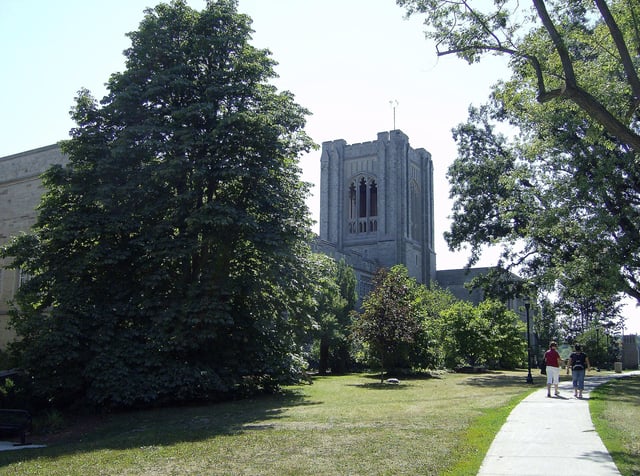
The Spencer Engineering Building is primarily used by Western's Faculty of Engineering. The faculty is one of eleven faculties at the university.
Western is a publicly funded research university, and a member of the Association of Universities and Colleges of Canada.[74] The full-time undergraduate programs comprise the majority of the school's enrollment, made up of 30,665 full-time, part-time undergraduate students and concurrent education students. The graduate student population is 5,297, including full-time students, part-time students and post-graduate medical residents.[5] The university conferred 4,504 bachelor's degrees, 207 doctoral degrees, 1,427 master's degrees, and 1,180 second entry professional degrees in 2008–2009.[75] Students may apply for financial aid such as the Ontario Student Assistance Program and Canada Student Loans and Grants through the federal and provincial governments. The financial aid may come in loans, grants, bursaries, scholarships, fellowships, debt reduction, interest relief, and work programs.[76]
The university is divided into 11 faculties and schools including the Don Wright Faculty of Music, the Faculty of Arts & Humanities, Faculty of Education, Faculty of Engineering, Faculty of Health Sciences, Faculty of Information & Media Studies, Faculty of Law, Faculty of Science, Faculty of Social Science, Ivey School of Business, and the Schulich School of Medicine & Dentistry.[77] In September 2016, most undergraduates at Western was enrolled in the Faculty of Social Sciences, with 7,114 full-time and part-time undergraduate students in enrolled in one of their programs.[78][79] In the same year, the Faculty of Health Science held the highest enrolment among graduate students at Western, with 821 full-time and part-time graduate students enrolled in the faculty.[80] The School Graduate and Postdoctoral Studies is the university's central administrative unit of graduate education.[81] However, it is not considered its own faculty or academic school.
Admission requirements at Western differ depending upon the education system where the applicant originates from, due to the lack of uniformity in marking schemes.[82] In September 2012 secondary school average for full-time first-year students at Western was 89.3 percent.[83] For admission in the fall of 2013, there were 45,000 applications for 4,900 spaces.[84]
Reputation
The University of Western Ontario has consistently ranked in international university rankings. In the 2019 Academic Ranking of World Universities rankings, the university ranked 201–300 in the world and 10–12 in Canada.[85] The 2020 QS World University Rankings ranked the university 211th in the world and eighth in Canada.[86] The 2019 Times Higher Education World University Rankings ranked Western 190th in the world, and eighth in Canada.[87] In U.S. News & World Report 2019 global university rankings, the university placed 276th in the world, and eleventh in Canada.[88] In Maclean's 2019 rankings, Western placed seventh in both their Medical-Doctoral university category, and sixth in their reputation ranking for Canadian universities.[89]
The university has also placed in a number of rankings that evaluated the employment prospects of its' graduates. In QS's 2019 graduate employability ranking, the university ranked 141-150 in the world, or seventh in Canada.[91]
Research
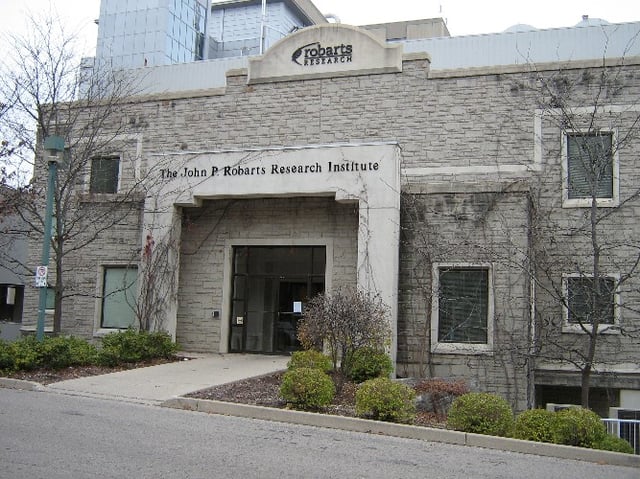
Robarts Research Institute is a medical research facility at Western's campus. More than 600 people conduct basic and clinical research at the facility.
Western has four primary fields of research: life sciences and the human condition, culture analysis and values, the human and physical environments, and social trends, public policy, and economic activity.[92] In Research Infosource's 2018 ranking of Canadian research universities, Western was ranked 10th; with a sponsored research income (external funding) of $249.669 million in 2017.[93] In 2017, members of Western's faculty averaged a sponsored research income of $166,100, while graduate students averaged a sponsored research income $41,600.[93] The federal government is the largest source of funding providing 46 percent of Western's research budget, primarily through grants. Private corporations contribute 10 per cent of Western's research budget.[94]
Western's research performance has been noted several bibliometric university rankings, which uses citation analysis to evaluates the impact a university has on academic publications. In 2019, the Performance Ranking of Scientific Papers for World Universities ranked Western 197th in the world, and ninth in Canada,[95] whereas the University Ranking by Academic Performance 2018–19 rankings placed the university 187th in the world, and ninth in Canada.[96]
Research regarding the human brain has also become a major focus at the university. The Brain and Mind Institute focuses on research in cognitive neuroscience at Western.[97] and the Institute recently discovered the blind may echolocate by using the visual cortex of the brain.[98] Another recent study at Western has suggested people deaf from birth may be able to reassign the area of their brain used for hearing to boost their sight.[99]
In 2014, the university unveiled plans for a 4,200-square-foot facility for research in medicine, science and technology, in the study of HIV and other complex human pathogens. Schulich School of Medicine & Dentistry's Department of Microbiology and Immunology is globally recognized, in large part due to the groundbreaking discoveries of Dr. Chil-Yong Kang, a Western researcher clinically testing a preventative HIV/AIDS vaccine.[100] SAV001-H is the first and only preventative HIV vaccine based on a genetically modified killed whole HIV-1 virus. The United States Food and Drug Administration (FDA) Phase I clinical trial was completed in August 2013[101] and reported no serious adverse effects while boosting antibodies in the volunteers. The vaccine SAV001-H holds tremendous promise, having already proven to stimulate strong immune responses in preliminary toxicology tests. It is the only HIV vaccine under development in Canada, and one of only a few in the world.[102]
Student life
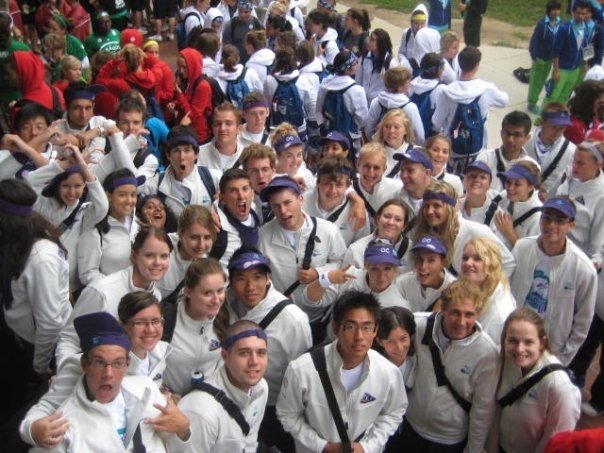
O-week at Western is a week of activities to orient and welcome new students.
| Undergraduate | Graduate | |
|---|---|---|
| Male | 45% | 46.7% |
| Female | 55% | 53.3% |
| Canadian student | 91.2% | 78.5% |
| International student | 8.8% | 21.5% |
The two main student unions on administrative and policy issues is the University Students' Council for all undergraduate students and the Society of Graduate Students for graduate students.[104][105] The University Students' Council recognizes more than 180 student organizations and clubs, in which more than 19,500 people are a member.[106] These clubs and organizations cover a wide range of interests such as academics, culture, religion, social issues, and recreation.[107] The University Students' Council also provides additional services such as the campus movie theatre (Western Film), pub/restaurant (The Spoke & Rim Tavern), clothing store (The Purple Store) and print shop.[108] These facilities can all be found in the University Community Centre.
There are a number of fraternities and sororities existing throughout the student community. There are five international sororities at Western, Alpha Gamma Delta, Alpha Omicron Pi, Alpha Phi, Kappa Alpha Theta & Pi Beta Phi.[109] There are also ten fraternities existing at Western, Alpha Epsilon Pi, Delta Upsilon, Kappa Sigma, Phi Delta Theta, Phi Gamma Delta, Pi Kappa Alpha, Lambda Chi Alpha, Sigma Chi, Zeta Psi, and Kappa Alpha Society.[110][111][112][113][114][115][116]
Athletics

The Western Mustangs compete in a number of sports, including Canadian football.
Athletics at Western is managed by Sports & Recreation Services, a division of the Faculty of Health Sciences.[117] The university's varsity teams compete in the Ontario University Athletics conference of U Sports. The varsity teams are known as the Western Ontario Mustangs. As is mandatory for all members of U Sports, Western does not provide full-ride athletic scholarships.[118] Western's varsity teams have been highly successful. In particular, the football team has won 30 provincial championships, appeared in 12 national championship finals and won 6 Vanier Cups as national champions. Basketball has won 24 provincial championships and rowing has won 23 provincial championships.
The university has a number of athletic facilities open to their varsity teams and their students. The Western Student Recreation Centre, opened in January 2009, is home to Western's group fitness, drop in recreation, registered massage therapy, sport psychology, drop in recreation, intramural sports and clubs.
Better known as the WSRC or the Rec Center, this facility has an 8-lane, 50-metre pool facility. Overlooking the pool is a 3-tiered concrete viewing area. A 1-metre diving board is also available. There is over 19,000 square feet of weight, cardio, and stretching space within the WSRC. There are three gyms on the first floor, and two more on the upper level. Outside the lower gyms is the 1st floor games and activity lounge for table tennis, while outside of the upper gym spaces is cardio space as well as the destination for spin bike programming. Also on the 4th floor are two large studio spaces where the drop in fitness, clubs and dance courses take place.[119]
TD Stadium has been the university's main stadium since it opened in 2000, with a seating capacity of over 8,000 spectators. The stadium is home to the university's varsity football team, and has hosted a number of events including the World Lacrosse Championships and the Canada Games.[120] The Thompson Recreation & Athletic Centre which houses a number of athletic venues, including an ice rink, tennis facilities and a track, is home to the varsity ice hockey teams and the varsity track and field teams.[121] Another athletic facility at the university is Alumni Hall, which is a multipurpose venue for sports such as basketball, volleyball and other indoor events.[122]
Many Western students take part in intramural sport leagues and tournaments.[123] Opportunities are offered at multiple skill levels and across a variety of sports. Sports offered include traditional sports like volleyball, basketball and soccer, as well as less traditional events like dodgeball and inner tube water polo. Western also hosts secondary school football games at TD Stadium.[124] Western has several fight songs and school songs that may be heard at varsity games, including the official school song, "Western". Written in 1930, it is most notably played at football games and other athletic events by the Western Mustang Band.[125]
Performances
The Don Wright Faculty of Music offers almost 400 performances, masterclasses and recitals each year, most of which are open to the public. The Western University Symphony Orchestra and the Western University Chamber Orchestra perform regularly under conductor Alain Trudel. UWOpera, under the direction of Theodore Baerg, performs a wide variety of repertoire ranging from operetta to full operatic works in the Paul Davenport Theatre (refurbished and renamed in 2009 from Talbot Theatre).[126]
Theatre Western produces a season that includes an annual musical revue of modern and classic Broadway, Purple Shorts (Western's One-Act Play Festival,) and a major musical production each spring. The Huron Underground Dramatic Society (HUDS) is a student run drama group that puts on several shows per year.
Media
The university's student population operates a number of media outlets throughout the campus environment.
The University Students' Council owns and operates the campus radio station CHRW-FM (94.9 FM).[127] The first campus radio to operate at Western was in 1971, although the present day station CHRW-FM, was not established until 1979, one year after the closure of the Western's first campus radio station.[128]
Newspaper
The Gazette, sometimes called the Western Gazette, is a student newspaper which has been in publication since 1906.[131] The Gazette publishes online daily and in print on Tuesdays during the academic year.[132][133] The Gazette has its roots as a hand-written literature newspaper called In Cap And Gown, which began in 1902.[134] The In Cap And Gown was first produced in newsprint in November 1906, but changed its name to The Gazette in 1908.[134] The Gazette ceased publishing in the spring of 1916 due to World War 1 but was revived in its old form in 1919. In 1930, 7 years after Western University changed its name to the University of Western Ontario, the paper changed its name to the University of Western Ontario Gazette. It is now known simply as The Gazette, its affiliation with Western variously recognized in its print edition as "Western University's official student newspaper." The Gazette started as monthly but in its early years appeared weekly and twice weekly.[135] It started publishing four times a week in 1991 and returned to the twice-weekly format in 2015. The change in print publication schedule was accompanied by a major digital transformation. The newspaper has moved towards a digital-first philosophy and focuses on multimedia and online-only content on a daily basis.[136] In 2017, the Gazette began printing only once a week.
The Gazette has spawned several other publications in its history. One was Occidentalia, which had its roots in special convocation issues of the Gazette which included pictures of the graduating class.[137] "Oxy" as it was known became the University's year book and it provided "an interesting record of the year's activities in all Faculties and Schools."[135] The paper is owned and published by the University Students' Council (USC). The paper has editorial autonomy from the USC.[133] The publications committee consists of mainly professional journalists who advise the full-time staff on editorial decisions and financial management of the paper, as well as offer an intermediary between the sometimes contentious relationship between the student politicians who are reported on by the Gazette.[138] The paper is one of the founding members of the National University Wire.[139]
International studies
The University of Western Ontario offers a variety of international exchanges and study abroad programs. Almost four hundred students come to Western each year as exchange students from all over the world, with even more students coming to Western as international undergraduate or exchange students. The Western International Exchange Program offers its students the opportunity to study at more than 85 different institutions in 25 countries.[140]
Leadership Education Program
The Leadership Education Program is designed to teach students how to become effective leaders, both individually and in teams. The program is split into three tiers: individual leadership, group leadership, and community leadership. To successfully complete a tier an individual must complete at least five of its seven modules.[141]
Upon completion, students receive a Letter of Accomplishment signed by the dean of the university.
Notable alumni
As of November 2007, the University of Western Ontario has over 220,000 alumni residing in over 100 countries.[142] Throughout Western's history, faculty, alumni, and former students have played prominent roles in many different fields and have won the Nobel Prize, Pulitzer Prize and other awards such as the Rhodes Scholarship.[143][144] Former faculty member Frederick Banting received the Nobel Prize in Physiology or Medicine for his discovery of insulin.[145] Alice Munro, who won the Nobel Prize in Literature in 2013, studied in the university's English department for two years under a scholarship and returned to Western in 1974-75, when she held the post of writer-in-residence. She was later awarded an honorary degree.[146] Two graduates from Western have also traveled in space, namely Bjarni Tryggvason and Roberta Bondar.[147][148]
Many former students have gained local and national prominence for serving in government, such as James Bartleman, who served as Lieutenant Governor of Ontario from 2002 to 2007, and Sheila Copps who served as Deputy Prime Minister of Canada.[149] Western's alumni also include a number of provincial premiers, including former premiers of Ontario John Robarts and David Peterson,[150] and the former premier of Alberta, Don Getty.[151] A number of graduates have also served prominent positions on the international level. Examples include Glenn Stevens,[152] the Governor of the Reserve Bank of Australia and Margaret Chan, the Director-General of the World Health Organization.[153]
A significant number of prominent leaders in business and economics have also studied at Western. Examples include: Stephen Poloz, Governor, Bank of Canada,[154] Thomas H. Bailey, founder and former chairman of Janus Capital Group,[155] Geoff Beattie, president of The Woodbridge Company and chairman of CTVglobemedia,[156] George Cope, president and CEO of Bell Canada Enterprise,[157] Joseph Muncaster, president of Canadian Tire,[158] Edward Rogers III, deputy chairman of Rogers Communications, and former president of Rogers Cable,[159] Arkadi Kuhlmann, chairman of ING Direct,[160] Rob McEwen, founder, chairman and former CEO of Goldcorp Inc.,[161] John Thompson, former chairman of Toronto-Dominion Bank and chancellor of Western,[162] Prem Watsa, chairman, CEO of Fairfax Financial,[163] Lee Seng Wee, former chairman of Oversea-Chinese Banking Corporation,[164] Galen Weston, chairman and president of George Weston Limited,[165] Howard Lindzon, author and founder of StockTwits,[166] businesswoman Margaret Heng, CEO of Shatec, a Singapore-based hospitality training institution,[167] and Kevin O'Leary, television personality, venture capitalist, and former president of The Learning Company.[168]
See also
15025 Uwontario
Old Four
St. Peter's Seminary (Diocese of London, Ontario)
Western Mustang Band
